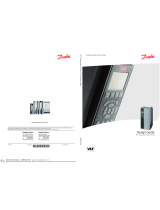
Decentral Solutions - Design Guide
installations reduces both time and risk as wiring for
motor, control and sensors are already in place and
maintained during transportation. The need for highly
skilled experts is reduced and local labour can do a
larger part of the installation. The commissioning costs
and OEM resources on-site will be reduced.
■Improved EMC
Electrical noise emitted is proportional to cable
length. The very short - or eliminated - cable
between motor control and motor in decentralised
installations therefore reduces emitted electrical noise.
In decentralised installations, the machine builder
normally mounts cables between motor controls and
motors in the machine leaving only power cables
and fieldbus cables with no EMC emission to be
installed at the production site. The risk of electrical
noise from motor controls to disturb other electrical
equipment caused by a faulty installation will diminish
and you avoid time-consuming fault finding in the
commissioning phase, where time frame is tight.
■Adapts to standard and special motors
Danfoss’ decentralised motor controls, FCD 300 and
DMS 300, are designed to control standard AC
asynchronous motors. Their flexibility allows them
also to adapt to special motor types. An example
is the AMT feature (Automatic Motor Tuning) in the
FCD 300. Combining Danfoss frequency converters
to Danfoss geared motors makes it even easier
as they fit mechanically and the motor data are
already stored in the FCD 300 memory. Combined
motor-drives are provided pre-assembled directly
from Danfoss removing the need for mechanical
fitting between motor and control.
Danfoss geared motor with FCD 300
■Minimum thermal losses
Danfoss frequency converters feature the unique
VVC switch principle to generate motor voltages.
Due to the VVC principle, power losses in the
motoraresimilarorlessthanthelossesinamotor
connected to mains. Thermal losses are minimised
and overheat is prevented. At the same time, the
VVC principle ensures nominal torque at nominal
speed and eliminates bearing currents.
Slim DC-links
It takes two steps to convert the frequency to vary
the speed of an AC motor: A rectifier and an inverter.
As the rectifier itself produces a rippled DC voltage,
a capacitor is often introduced to smoothen the
voltage supplied to the inverter. A link between
rectifier and inverter with only a small capacitor to
even out the voltage is called a "slim DC link". With a
slim DC link, the inverter will not be able to provide
quite the same voltage amplitude as supplied by the
mains supply, leading to lower efficiency. A special
pulse-width-modulation can be used to compensate
the ripple from a slim DC link. In this case the output
voltage for the motor still does not reach the rated
supply voltage value leading to an over-consumption
of motor current up to 10% and this will increase
the motor heating. Low efficiency and need of an
oversized motor is the result. As torque decreases with
the square of voltage the application will be exceeding
sensible to load-changes and speed sensors might be
required. At start, only nominal torque is available.
Principle of a frequency converter using
a DC link coil
The Danfoss option is to add coils to the DC link
inalldrivesasshowninthefigure. Thiswaya
high DC link voltage with a very low voltage ripple
is obtained and the electric strength of the drive
with regard to line transients is improved.
Further advantages are the prolonged lifetime of the
capacitors, reduced harmonic disturbance of the net
supply and presence of 150-160% start torque.
Numerous manufacturers of frequency inverters
use slim DC links leading to bad efficiency rates
– even if users due to the activity of for instance
the CEMEP now tend to use high efficiency
motors - meeting at least EFF2.
MG.90.F3.02 - VLT is a registered Danfoss trademark
10





















